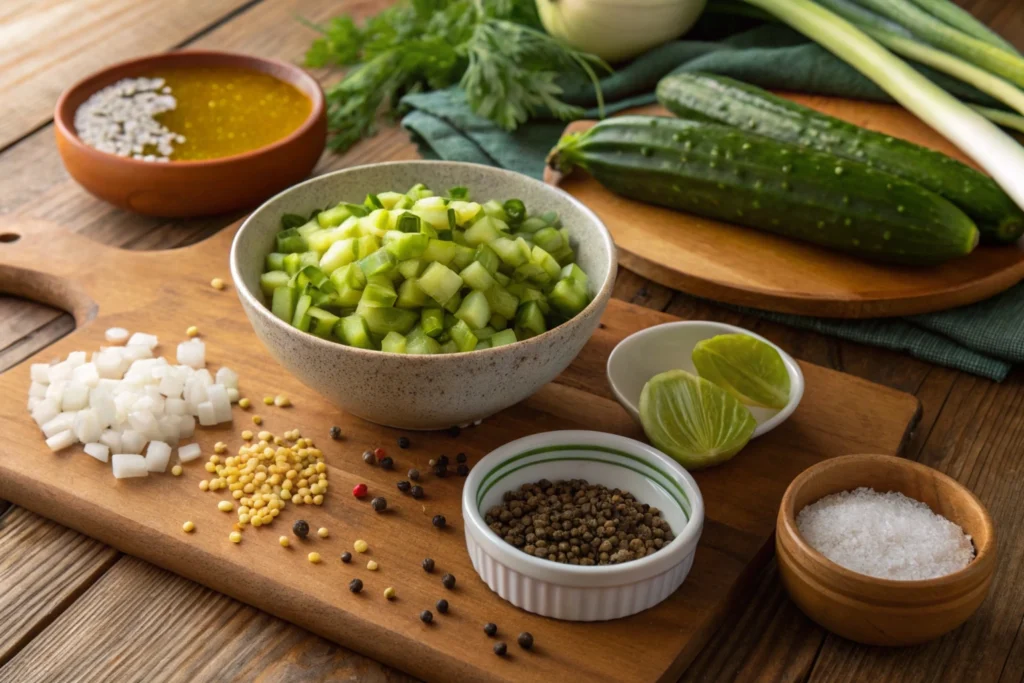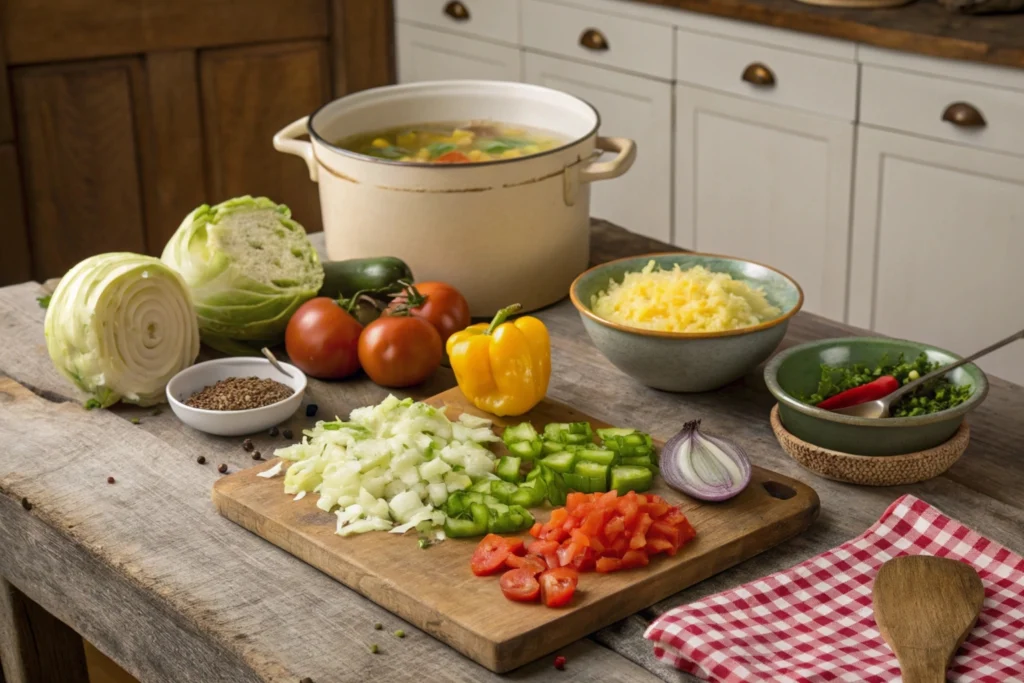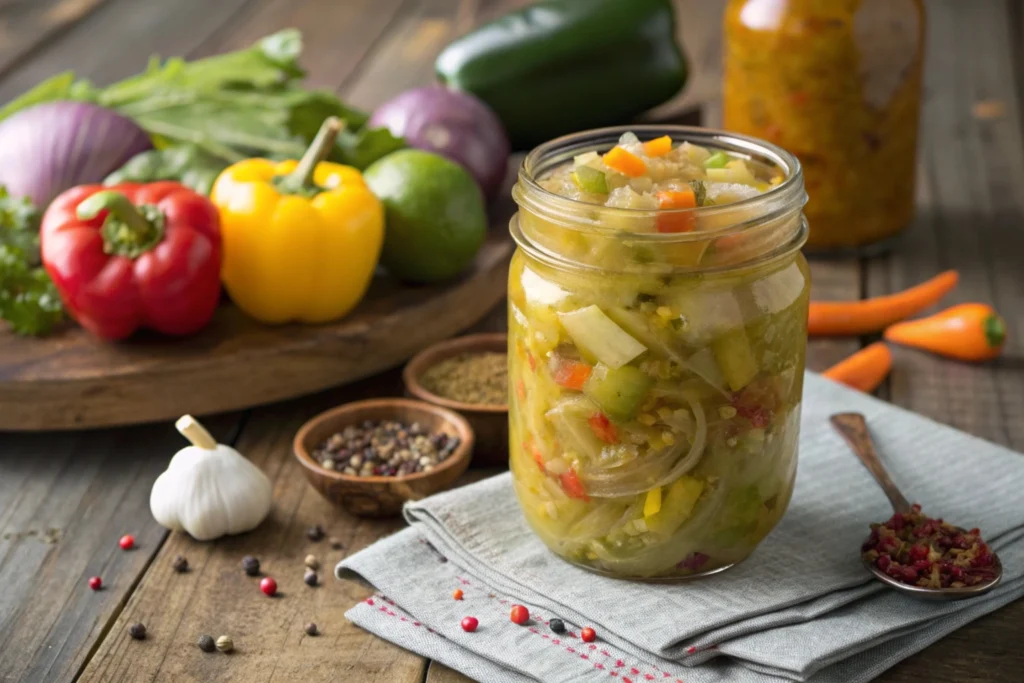Many people enjoy pickle relish and chow chow for their flavorful additions to meals, but they often struggle to understand the differences between these two condiments. While both are tangy, flavorful, and versatile, they each have unique histories, ingredients, and culinary roles. This article will dive deep into what sets pickle relish apart from chow cho by exploring their origins, preparation methods, and how they add a burst of flavor to different dishes. Let’s break it down, part by part!
Introduction to Pickle Relish and Chow Chow
What is Pickle Relish?
Cooks make pickle relish by finely chopping or pureeing pickled cucumbers and seasoning them with vinegar, sugar, and spices. It can be sweet, sour, or savory, depending on the recipe, and its texture makes it ideal for spreading or mixing into dishes. Originating in Europe, it gained popularity as a way to preserve vegetables while adding bold flavors to food. From topping hot dogs to enhancing sandwiches, its versatility knows no bounds.
What is Chow Chow?
Chow chow, in contrast, originates from Southern and Pennsylvania Dutch cuisines as a chunky relish. Cooks make it with a mix of vegetables like cabbage, green tomatoes, onions, and peppers, seasoning it with mustard seeds, turmeric, and vinegar for a tangy kick. Its texture is heartier than pickle relish, and people often serve it as a side or topping for meats, beans, and other robust dishes. Each region has its twist, making it a fascinating study in culinary diversity.
How Are They Similar and Different?
Both condiments aim to elevate meals, but they differ significantly in ingredients, texture, and flavor profiles. Pickle relish often leans sweet, while chow chow typically has a spiced tang. Moreover, pickle relish focuses on cucumbers, whereas chow chow showcases a medley of vegetables. These contrasts are what make them special and suited for different culinary purposes.
Historical Background
Origins of Pickle Relish
Pickle relish traces its roots back to ancient civilizations, where people sought creative ways to preserve surplus crops. The concept of pickling, using vinegar and salt, originated thousands of years ago in Mesopotamia and spread across Europe and Asia. Over time, Europeans adapted the method to create finely chopped relishes that could complement meats and breads. By the 19th century, pickle relish had become a staple in Western cuisines, particularly in England and the United States.
The cultural significance of pickle relish is undeniable. In America, its popularity skyrocketed during the early 20th century, thanks to hot dog vendors and sandwich shops. Today, people worldwide enjoy various types of relishes, including sweet relish, dill relish, and spicy versions infused with peppers. Each variation tells a story of regional preferences and culinary ingenuity.
Origins of Chow Chow
Southern and Pennsylvania Dutch cuisines deeply influence chow chow’s history, though its exact origins remain unclear. Some trace its inspiration to Chinese immigrants in the 18th and 19th centuries, while others link it to French Canadian culinary traditions. Regardless, it evolved into a vibrant and versatile condiment that symbolizes resourcefulness in food preservation.
The cultural importance of chow chow is immense. People traditionally made it at the end of the growing season, using leftover vegetables that would otherwise go to waste. Over time, regional variations emerged, with some versions sweeter and others more tangy and spiced. From Appalachian homes to Southern barbecue joints, chow chow remains a cherished tradition.
Ingredients and Preparation of Pickle Relish and Chow Chow
Common Ingredients in Pickle Relish

The backbone of pickle relish is, unsurprisingly, pickled cucumbers. Cooks finely chop the cucumbers and combine them with a flavorful brine made of vinegar, sugar, and spices. Additional ingredients like onions, mustard seeds, and celery seeds enhance its complexity.
Recipes vary widely. For example, sweet pickle relish features more sugar, while dill relish leans on garlic and dill for a savory punch. Some variations even include chopped peppers for heat or turmeric for color. This adaptability ensures that there’s a version of pickle relish to suit nearly every palate.
Common Ingredients in Chow Chow
Chow chow is a medley of vegetables, often including cabbage, green tomatoes, onions, bell peppers, and sometimes corn. Cooks coarsely chop these ingredients and mix them with a tangy brine made of vinegar, sugar, and spices like mustard seeds, celery seeds, and turmeric. The seasoning gives chow chow its signature bold and slightly spicy flavor.
Regional recipes add their own flair. Southern chow chow often includes hot peppers for a kick, while Pennsylvania Dutch versions lean sweeter. This flexibility makes chow chow a dynamic addition to a wide range of dishes.
Preparation Methods for Pickle Relish
Making pickle relish at home is straightforward and rewarding. Start by finely chopping cucumbers and onions. In a large bowl, mix them with salt and let the mixture sit for a few hours to draw out excess moisture. Rinse thoroughly and set aside.
Next, prepare the brine by simmering vinegar, sugar, and spices like mustard seeds and celery seeds. Add the chopped vegetables to the brine and cook until tender, ensuring the flavors meld beautifully. Finally, transfer the relish to sterilized jars and seal them tightly. For long-term storage, process the jars in a boiling water bath to preserve them safely.
Pickle relish is not only delicious but also highly adaptable. Experiment with adding peppers or altering the sweetness level to suit your preferences. Its versatility ensures it can complement everything from burgers to egg salads.
Preparation Methods for Chow Chow

Creating chow chow involves several steps, but the result is worth the effort. Begin by coarsely chopping a mix of vegetables, such as cabbage, green tomatoes, and onions. Sprinkle them with salt and let them sit overnight to draw out water. This step is crucial for achieving the perfect texture.
The next day, prepare a tangy brine by combining vinegar, sugar, and spices like mustard seeds and turmeric in a large pot. Add the drained vegetables to the brine and simmer until the mixture is well-coated and slightly softened. Spoon the mixture into sterilized jars, leaving a little headspace, and seal the lids.
For a longer shelf life, process the jars in a boiling water bath. Chow chow’s vibrant flavor makes it an excellent condiment for smoked meats, beans, and even salads. You can tweak the recipe to emphasize either sweetness or spiciness, ensuring it suits your personal taste.
Flavor Profiles and Uses of Pickle Relish and Chow Chow
Flavor Profile of Pickle Relish
Pickle relish offers a bright, tangy, and slightly sweet taste that can range from mild to bold, depending on its ingredients. The balance of vinegar and sugar creates its signature tang, while spices like mustard seed and celery seed add layers of complexity. Sweet pickle relish tends to have a more sugary flavor, making it ideal for complementing savory dishes, whereas dill relish delivers a sharper, garlicky punch.
The flavor can vary significantly based on preparation techniques. For instance, the type of vinegar—apple cider, white, or malt—used in the brine affects the overall acidity. The freshness of the cucumbers and additional vegetables also plays a role, with fresher produce yielding brighter flavors. This adaptability is what makes pickle relish a favorite across cuisines.
Flavor Profile of Chow Chow
Chow chow’s flavor profile is robust, tangy, and often spiced with a hint of sweetness. The combination of vinegar, sugar, and spices like turmeric and mustard seeds gives it a bold and slightly peppery kick. Depending on the recipe, chow chow can lean sweeter or spicier, reflecting the preferences of its regional origins.
The texture of chow chow, with its chunkier vegetable pieces, also influences the eating experience. Factors such as the variety of vegetables, the spice blend, and the vinegar used significantly shape its flavor. Southern chow chow, for instance, might include hot peppers for added heat, whereas Pennsylvania Dutch chow chow is typically sweeter and milder. These nuances make chow chow a versatile condiment for both traditional and modern dishes.
Culinary Uses of Pickle Relish
Pickle relish is a versatile condiment that enhances a wide array of dishes. It’s famously paired with hot dogs, hamburgers, and sausages, where its tangy sweetness balances the rich, savory flavors. In sandwiches, it adds a zesty layer that complements everything from deli meats to grilled cheeses.
Beyond its role as a topping, pickle relish is often used in salads like potato salad, egg salad, and coleslaw to add brightness and depth. It’s a common ingredient in tartar sauce, where its tangy notes shine alongside fried seafood. In some regions, relish even makes its way into deviled eggs or dips, proving its adaptability.
Regionally, pickle relish varies in its culinary applications. For instance, sweet pickle relish is a classic addition to Southern-style pimento cheese, while spicy variations are popular in Tex-Mex-inspired dishes. Its wide-ranging uses make it a kitchen staple for both everyday meals and special occasions.
Culinary Uses of Chow Chow
Chow chow is celebrated for its versatility in Southern and Pennsylvania Dutch cuisines. It’s often served as a side dish or relish, pairing beautifully with smoked meats like pulled pork, barbecue, or ham. Its tangy, spiced flavor cuts through the richness of these dishes, creating a perfect balance.
In addition to meats, chow chow is a common topping for beans, particularly pinto or black-eyed peas. Its acidity and spice add depth to the earthy flavor of legumes. Chow chow also complements sandwiches and burgers, much like pickle relish, but its chunkier texture provides a more substantial bite.
Regional specialties highlight chow chow’s adaptability. In the South, it’s sometimes used as a base for dips or mixed with cream cheese for a spread. Meanwhile, Pennsylvania Dutch versions are often served as part of a hearty, family-style meal, accompanying roasts and pickled vegetables. Chow chow’s unique blend of flavors and textures makes it a culinary standout.
Nutritional Information and Storage
Nutritional Comparison
Both pickle relish and chow chow are relatively low in calories, making them excellent choices for adding flavor without significantly increasing calorie intake. Pickle relish is typically higher in sugar, especially in sweet varieties, which can increase its calorie and carbohydrate content. On the other hand, chow chow’s nutritional profile varies depending on whether it’s made with more vegetables or additional sweeteners.
Both condiments are rich in antioxidants and probiotics if prepared with natural fermentation methods. The use of vinegar and spices like turmeric also contributes to potential health benefits, such as improved digestion and anti-inflammatory properties. However, it’s worth noting that commercial versions of both often contain added preservatives or sodium, so moderation is key.
Storage and Shelf Life
Proper storage is essential for maintaining the quality and safety of both pickle relish and chow chow. Unopened jars of either condiment should be stored in a cool, dry place away from direct sunlight. Once opened, they should be refrigerated and tightly sealed to prevent contamination.
The shelf life of commercial pickle relish and chow chow is typically several months to a year, depending on the brand and preservatives used. Homemade versions, if properly canned, can last up to a year unopened but should be consumed within a few weeks after opening. Always check for signs of spoilage, such as an off smell, discoloration, or mold, before using.
Frequently Asked Questions
What is the difference between pickle relish and chow chow?
The main difference lies in their ingredients, texture, and flavor profiles. Pickle relish primarily consists of finely chopped pickled cucumbers mixed with a sweet or tangy brine, while chow chow is a chunky mixture of vegetables like cabbage, green tomatoes, and peppers seasoned with spices such as mustard seeds and turmeric. Relish often leans sweeter, whereas chow chow is tangier and spicier.
Can pickle relish and chow chow be used interchangeably?
It depends on the dish. Both can add tang and flavor, but their textures and taste profiles are distinct. Pickle relish works better for sandwiches, hot dogs, or tartar sauces due to its finer texture and sweetness. Chow chow’s heartier texture and spicier flavor are more suited to beans, smoked meats, or side dishes.
How long do pickle relish and chow chow last after opening?
When refrigerated, both condiments typically last 1–2 months after opening. Ensure the jars are tightly sealed and free of contamination. Homemade versions, if canned properly, may last longer unopened but should be consumed within a few weeks after opening.
Are there any health benefits to eating pickle relish or chow chow?
Yes! Both contain vinegar, which may aid digestion, and spices like turmeric, which have anti-inflammatory properties. Additionally, if naturally fermented, they can offer probiotics. However, some commercial versions are high in sugar or sodium, so moderation is essential.
Can I make pickle relish or chow chow at home?
Absolutely! Both are straightforward to make with readily available ingredients. Homemade versions allow for customization, whether you prefer a sweeter relish or a spicier chow chow. Proper canning techniques ensure safety and extended shelf life.
What are some popular dishes that use pickle relish or chow chow?
Pickle relish shines in dishes like potato salad, hot dogs, burgers, and tartar sauce. Chow chow complements smoked meats, beans, and Southern-style meals. Both can also be used creatively in dips, spreads, or even as pizza toppings.
Conclusion
Pickle relish and chow chow are two distinct yet equally delightful condiments, each bringing its own unique flavor to the table. While pickle relish is known for its sweet and tangy cucumber base, chow chow stands out with its chunky, spiced vegetable mix. These differences influence their culinary applications, making relish ideal for sandwiches and salads and chow chow perfect for hearty, Southern-inspired meals.
When choosing between them, consider your dish and flavor preference. Relish adds brightness and sweetness, while chow chow delivers bold, tangy, and sometimes spicy notes. Whichever you choose, both condiments are versatile, flavorful, and a joy to make or eat. Enjoy experimenting with these kitchen staples to enhance your meals!

